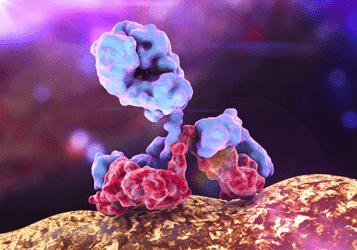- Home
- Products
- Customized ADCs
- NECTIN4
- Anti-Nectin-4-Mc-vc-MMAE ADC-1
Anti-Nectin-4-Mc-vc-MMAE ADC-1 (CAT#: ADC-W-429)
This ADC product is comprised of an anti-Nectin-4 monoclonal antibody (clone T-14) conjugated via a Mc-VC linker to MMAE. The MMAE is targeted to certain cancers by immunerecognition and delivered into cancer cells via receptor mediated endocytosis. Within the cell, MMAE binds to tubulins, interrupts microtubule dynamics, and subsequently, induces cell death.
- Product Information
- ADC Target
- ADC Antibody
- ADC Linker
- ADC payload drug
- Antibody clone #
- T-14
- Name
- Nectin-4
- Alternative Names
- PVRL4; poliovirus receptor-related 4; LNIR; PRR4; EDSS1; nectin-4; nectin-4; nectin 4; Ig superfamily receptor LNIR; poliovirus receptor-related protein 4;
- Target Entrez Gene ID
- 81607
- Target UniProt ID
- K4PZ75
- Overview
- This gene encodes a member of the nectin family. The encoded protein contains two immunoglobulin-like (Ig-like) C2-type domains and one Ig-like V-type domain. It is involved in cell adhesion through trans-homophilic and-heterophilic interactions. It is a single-pass type I membrane protein. The soluble form is produced by proteolytic cleavage at the cell surface by the metalloproteinase ADAM17/TACE. The secreted form is found in both breast tumor cell lines and breast tumor patients. Mutations in this gene are the cause of ectodermal dysplasia-syndactyly syndrome type 1, an autosomal recessive disorder. Alternatively spliced transcript variants have been found but the full-length nature of the variant has not been determined.
- Overview
- Anti-Nectin-4 Antibody, clone # T-14
- Clone #
- T-14
- Species Reactivity
- Human
- Name
- VC (valine-citrulline)
- Description
- Peptide linkers, belonging to Enzymatically cleavable linkers, combine greater systemic stability with rapid enzymatic release of the drug in the target cell. The scission of peptidic bonds relies on lysosomal proteolytic enzymes, which have very low activities in blood due to endogenous inhibitors and the unfavorably high pH value of blood.
- Name
- MMAE (Monomethyl auristatin E)
- Description
- Derived from Auristatin,are water-soluble dolastatin analogs of dolastatin 10. Dolastatin 10 belongs to dolastatin family and it can powerfully bind to tubulin, thus inhibiting polymerization mediated through the binding to the vinca alkaloid binding domain, and causes cell to accumulate in metaphase arrest.
For Research Use Only. NOT FOR CLINICAL USE.
Related Products
- Anti-EPCAM (Tucotuzumab)-MC-Vc-PAB-DMEA-(PEG2)-duocarmycin SA ADC (CAT#: ADC-W-1087)
- Anti-CD79B (Polatuzumab )-SPDB-DM4 ADC (CAT#: ADC-W-2555)
- Anti-Fibrin II-beta chain (Biciromab)-SPDB-DM4 ADC (CAT#: ADC-W-1995)
- Anti-EPCAM (Adecatumumab)-SMCC-DM1 ADC (CAT#: ADC-W-1070)
- Anti-IL2RA (Daclizumab)-MC-Vc-PAB-MMAE ADC (CAT#: ADC-W-1373)
- Anti-CD3E (Catumaxomab)-MC-Vc-PAB-DMEA-(PEG2)-duocarmycin SA ADC (CAT#: ADC-W-2275)
- Anti-CD3D (Teplizumab)-MC-MMAF ADC (CAT#: ADC-W-832)
- Anti-TPBG-AcBut-calicheamicin ADC-1 (CAT#: ADC-W-008)
- Anti-CD33 ADC-1 (CAT#: ADC-W-068)
- Anti-CD4 (Keliximab)-MC-MMAF ADC (CAT#: ADC-W-868)
Published Data
+ Submit Publications

Scientific Resources
Customer Reviews and FAQs
There are currently no Customer reviews or questions for ADC-W-429. Click the button above to contact us or submit your feedback about this product.
Quick Links
Other Products
Same Target
Same Linker
Same Payload
| CAT# | Product Name | Linker | Payload |
| ADC-W-477 | Anti-NECTIN4-VC-MMAE ADC | VC (valine-citrulline) | MMAE (Monomethyl auristatin E) |
| ADC-W-428 | Anti-Nectin-4-VC-MMAE ADC-1 | VC (valine-citrulline) | MMAE (Monomethyl auristatin E) |
| CAT# | Product Name | Linker | Payload |
| ADC-W-477 | Anti-NECTIN4-VC-MMAE ADC | VC (valine-citrulline) | MMAE (Monomethyl auristatin E) |
| ADC-W-462 | Anti-GPNMB-VC-MMAE ADC | VC (valine-citrulline) | MMAE (Monomethyl auristatin E) |
| ADC-W-494 | Anti-SLC39A6-VC-MMAE ADC | VC (valine-citrulline) | MMAE (Monomethyl auristatin E) |
| ADC-W-564 | Anti-MUC16-VC-MMAE ADC | VC (valine-citrulline) | MMAE (Monomethyl auristatin E) |
| ADC-W-475 | Anti-CA9-VC-MMAE ADC | VC (valine-citrulline) | MMAE (Monomethyl auristatin E) |
| CAT# | Product Name | Linker | Payload |
| ADC-AA-017 | anti-HIgG(Fab)-C-MMAE ADC | Cleavable linkers | MMAE (Monomethyl auristatin E) |
| ADC-W-536 | Anti-EDNRB (endothelin B)-VC-MMAE ADC | VC (valine-citrulline) | MMAE (Monomethyl auristatin E) |
| ADC-AA-003 | anti-HIgG(Fc)-C-MMAE ADC | Cleavable linkers | MMAE (Monomethyl auristatin E) |
| ADC-W-529 | Anti-F3-VC-MMAE ADC-6 | VC (valine-citrulline) | MMAE (Monomethyl auristatin E) |
| ADC-AA-029 | anti-MIgG(Fc)Fab-C-MMAE ADC | Cleavable linkers | MMAE (Monomethyl auristatin E) |
Online Inquiry
Welcome! For price inquiries, please feel free to contact us through the form on the left side. We will get back to you as soon as possible.



